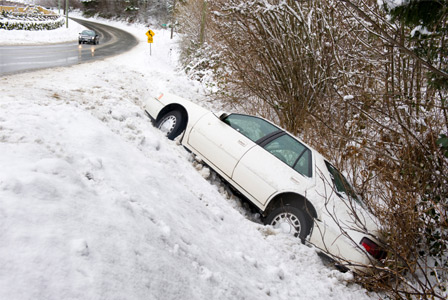Clik here to view.

Would you know what to do if your vehicle went into skid? We asked driving pro Eddie Wren for his lifesaving tips. His advice? Learn how to prevent a skid before it happens.
How to stop a skid
Don't be a know-it-all
When we asked Eddie Wren, president and chief instructor at Advanced Drivers of America, about skid recovery, we thought he'd recommend a driving class. We were surprised when he said skid-recovery classes are a terrible idea. "Even though it seems obvious that drivers should be taught 'how to get out of a skid,' 40 years of research from the top road safety research centers around the world has repeatedly and unequivocally shown that teaching people how to get out of a skid not only is ineffective, but much worse."
In fact, people who get skid-recovery training are more likely to crash after getting such training than those who don't get the training. While this sounded crazy at first, Wren says he now understands the primary reason for this phenomenon is that people who get skid-recovery training develop overconfidence — a subconscious belief that "even if I skid, I can get out of it." The result is reckless driving and more crashes at higher speeds.
Prevent a skid before it happens
Preventing a skid is far, far more important than any attempt to recover from one, says Wren. "Needing to attempt a 'cure' is the result of bad driving, and such attempts are by no means a guarantee that nobody will be hurt or killed — you or somebody else." Wren says the top causes of skidding are:
- Driving too fast for the conditions
- Braking too hard for the conditions
- Accelerating too hard for the conditions
- Steering too harshly for the conditions
- Taking a curve or a turn too fast for the conditions
- Falsely believing that SUVs and pickup trucks somehow have better grip which allows them to be driven faster in snow and ice conditions
In short, the best way to avoid a skid is to drive at sensible speeds, be prepared to slow down significantly if you are concerned about the conditions, and use the vehicle controls gently and in a timely manner.
How to recover from a skid
If you do find your vehicle in a skid, Wren tells drivers to remember the following:
- Keep both hands on the wheel. If anyone — including a state driver's manual — ever tells you that if you skid you should select neutral, that advice is potentially very dangerous. Keep both hands on the wheel!
- If you can, remove the cause of the skid.
- Look where you want your car to go and keep looking there, even if your car starts to spin. Eye-hand coordination is incredibly important and incredibly powerful.
- For a rear-wheel or all-wheel skid in which your car starts to spin out of line, "Steer into the skid," which means steer to the same side the back end of the car is sliding towards. During a front-wheel skid, straighten the steering wheel.
- If you do have ABS fitted to your vehicle, it is perfectly correct to follow the advice "Stomp and steer!" Remember that ABS is not there to help you stop sooner, it is a device that allows you to keep on steering while braking, and for that reason it is tremendously useful. "If you feel the brake pedal pulsing or fluttering under your foot, or you hear a sort of 'tattattattatta' noise while you are braking, that is just the ABS doing its job. Do not release the brake pedal unless there is some other unrelated and crucial reason to do so, which is immensely unlikely."
Image may be NSFW.
Clik here to view. Expert tip:
Expert tip:To gauge your following distance, Wren says you should watch the vehicle ahead of you as it passes something, then leave three seconds' gap on a dry road, six seconds on a very wet road, and 12 seconds on an icy or very slippery road.
More safe driving tips
10 Ways to avoid an accident
The how and why of rollovers
How to stop a hydroplane